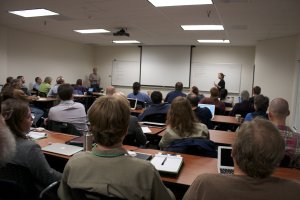Apply now for two NSF/NEON remote sensing data workshops
June 14, 2016
Applications are due on June 24 for two upcoming remote sensing data workshops that have been funded through an NSF Macrosystems Biology grant. One workshop will focus on NEON lidar data and the second will utilize NEON hyperspectral data. The workshop organizers are creating this training on using NEON remote sensing datasets to “enable new discoveries in the biophysical research community.”
Dr. Nancy Glenn, a professor in the Department of Geosciences of Boise State University, is excited to host the workshop series and said, “NEON is an amazing source of data for the research community.” Glenn’s background is in remote sensing, so she was immediately drawn to the data potential from NEON’s Airborne Observation Platform (AOP). “The hyperspectral and lidar data from NEON’s AOP are ripe for discovery!” said Glenn.
Glenn also said that once the ideas for the workshop series solidified, she was able to tap into a network of collaborators from a variety of institutions including OpenTopography, Arizona State University, Appalachian State University, UC Davis, UC Santa Barbara and Boise State University who had taught hyperspectral and lidar workshops before. NEON scientists also provided data and guidance to help create the workshops.
“We hope to demonstrate and teach others how the AOP data allow multi-scale analysis from point to landscape scale, through a series of 3 workshops – focused on hyperspectral (August 2016), lidar (September 2016), and ecosystem modeling (2017, date TBD). The workshops will enable scientists to forge new frontiers by teaching them how to use AOP data for a number of studies – such as interdisciplinary studies of ecology-hydrology-geomorphology.”
The courses will be hands-on workshops. Twenty-five participants will be selected for each workshop and the materials will be posted online for others to use as well.
Workshop #1: Mapping Species, Composition (Foliar Chemistry) and Soil Properties with Spectroscopy
This workshop that will consist of lectures and labs on imaging spectroscopy theory, pre-processing, spectral mixture analysis, and multivariate techniques to derive foliar chemistry. It will utilize NEON data and attendees will have the opportunity to bring their own datasets for analysis.
Workshop dates: August 29 -31, 2016
Application deadline: June 24, 2016
Location: Boise State University, Boise, Idaho
Presented by: UC Santa Barbara, Appalachian State, Boise State University Boise Center Aerospace Lab (BCAL), UC Davis and NEON
Instructors: Jessica Mitchell, Appalachian State; Dar Roberts, UC Santa Barbara; Susan Ustin, UC Davis; Nancy Glenn, Boise State University
Audience: This workshop is designed for researchers interested in using NEON data to derive remote sensing and biophysical variables for NEON science. Basic remote sensing background ideal but not required.
Learn more about how to apply for the hyperspectral data workshop.
Workshop #2: Topographic, Geomorphic, And Vegetation Analysis With Lidar
This workshop will be taught by OpenTopography and NEON lidar experts and will consist of lectures and labs on topographic, geomorphic, and vegetation analysis with lidar point clouds and derived products. The course will utilize NEON data and attendees will have the opportunity to bring their own datasets for analysis.
Workshop dates: September 28-30, 2016
Application deadline: June 24, 2016
Location: Boise State University, Boise, Idaho
Presented by: OpenTopography, Boise State University Boise Center Aerospace Lab (BCAL) and NEON
Instructors: Arrowsmith, Arizona State University, OpenTopography; Chris Crosby, UNAVCO, OpenTopography; Nancy Glenn, Boise State University
Audience: Researchers and students interested in using NEON data, including data from the airborne operation platform (AOP) to derive lidar products for NEON science. No background in lidar required.
Learn more about how to apply for the lidar data workshop.
The third workshop which will focus on ecosystem modeling is still be designed and more information will be posted once it becomes available.
About the NSF MacroSystems Biology and Early NEON Science program
The MacroSystems Biology and Early NEON Science: Research on Biological Systems at Regional to Continental Scales program supports quantitative, interdisciplinary, systems-oriented research on biosphere processes and their complex interactions with climate, land use, and invasive species at regional to continental scales as well as planning, training, and development activities to enable groups to conduct MacroSystems Biology and Early NEON Science research.
The next proposal deadline for this program is October 17, 2016
